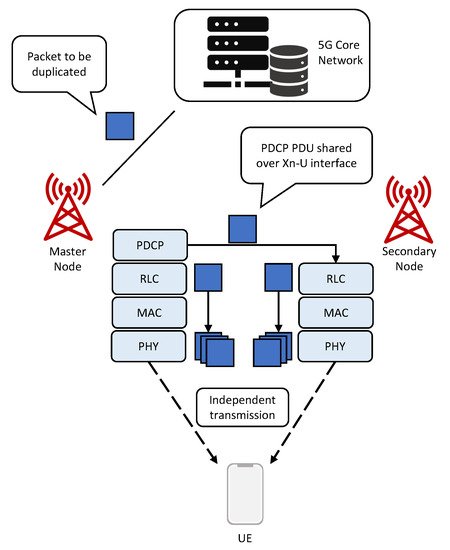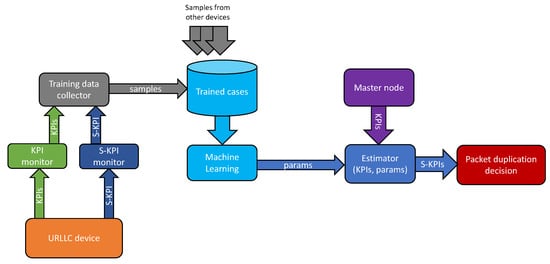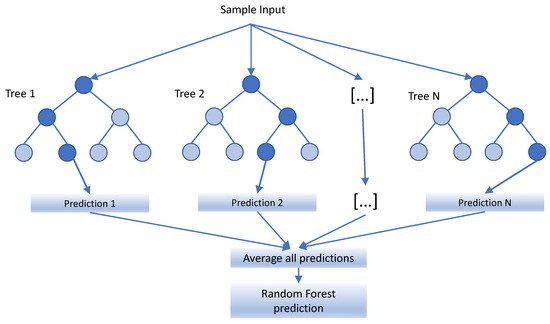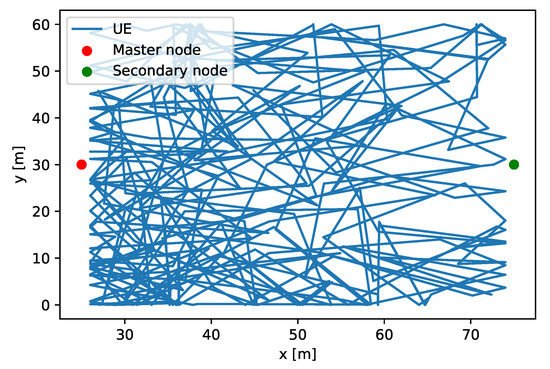The fifth-generation (5G) network is presented as one of the main options for Industry 4.0 connectivity. To comply with critical messages, 5G offers the Ultra-Reliable and Low latency Communications (URLLC) service category with a millisecond end-to-end delay and reduced probability of failure. There are several approaches to achieve these requirements; however, these come at a cost in terms of redundancy, particularly the solutions based on multi-connectivity, such as Packet Duplication (PD). Specifically, this entry proposes a Machine Learning (ML) method to predict whether PD is required at a specific data transmission to successfully send a URLLC message. This entry is focused on reducing the resource usage with respect to pure static PD.
1. Introduction
The advances in the fields of robotics, AI and Machine Learning (ML) converge in Industry 4.0 to adapt production to new customer demands, such as an increased customization, reduced costs and lower environmental impact
[1]. Wireless networks are a major enabler of flexibility in Industry 4.0, allowing easy reconfiguration of production lines, mobile appliances, such as robots both within and beyond the bounds of factories.
The fifth-generation (5G) radio technology, which has been standardized by the 3rd Generation Partnership Project (3GPP) members, aims to provide more flexibility to support new services and applications.
URLLC can support use cases, such as closed loop control, hazard sensors, robot automatization, augmented/virtual reality, drone communications and mobile eHealth. These use cases need advanced radio features and resource cost techniques to fulfill highly demanding latency and reliability targets. There are several approaches to achieve such requirements. One technique is the reduction of the time-slot duration by means of a higher numerology
[2][3] and by changing the radio resource scheduler
[4].
Another solution consists of eliminating steps in the connection protocols to reduce the access time—known as Grant-free transmission
[5]. Multi-connectivity
[6][7] has been proposed for the sake of achieving high reliability and low latency.
2. Background
2.1. 5G Multi-Connectivity Overview
Multi-connectivity in 5G New Radio (NR) inherits from the Long Term Evolution (LTE) Dual Connectivity (DC) concept. LTE DC was first specified in Release 12
[8] and allows UE to simultaneously send/receive data from different evolved NodeBs (eNBs). The data split is performed at the Packet Data Convergence Protocol (PDCP) layer of the transmitting eNB. At the receiving side, the information is decoded from lower layers, and it is combined at the PDCP layer on the receiver. This process allows boosting the throughput
[9].
In Release 15, multi-RAT DC was specified for DC operation with NR and LTE nodes
[10]. Not only data split but also PD at the PDCP layer is introduced. PD allows the same packet to be transmitted by different nodes, thus, improving the reliability. The nodes are commonly known as the Master Node (MN) and Secondary Node (SN) and are interconnected via a Xn interface. MN is in charge of activating/deactivating PD via Radio Resource Control (RRC) signaling
[11]. If the different links are spatially uncorrelated, transmitting the duplicate packet can compensate poor channel conditions. This is very important in industrial scenarios, where the fundamental problems are interference and multipath propagation, due to the presence of concrete walls and large metallic machinery and structures.
Moreover, NR-NR DC for standalone deployments was standardized in Release 16
[10], in which a UE is connected to one gNB that acts as a MN and another gNB that acts as a SN. In this entry, NR-NR DC with the PD approach is assumed for the downlink direction.
2.2. Packet Duplication for URLLC
PD is a multi-connectivity solution that improves reliability by increasing redundancy of the transmission. When PD is activated, the PDCP entity in the MN is responsible for PD, whereas the PDCP entity in the receiver is responsible for detecting and removing duplicated packets. The PDCP entity duplicates the packet data unit (PDU) to avoid twice performing functions, such as ciphering, header compression, integrity protection etc. This PDCP PDU has the same sequence number in both.
Then, the packet is forwarded by MN to the SN via Xn-U interface for transmission to the UE. The packet will undergo through independent Radio Link Control (RLC), Medium Access Control (MAC) and physical layer processing at each gNB. This implies that the packet can be transmitted at different time intervals and over different frequency resources and that physical transmission aspects, such as beamforming, MCS, ACK/NACK signaling and the Hybrid Automatic Repeat Request (HARQ) mechanism, are independent.
On the receiver side, multiple copies of the packet are received, and the UE will forward the first successfully received packet to the higher layers and remove duplicated packets received later, based on the PDCP sequence number. Figure 1 shows a 5G NR-NR PD scheme for downlink transmission.
Figure 1. A downlink packet duplication scheme in a NR-NR DC scenario.
3. Proposal
3.1. System Description
Figure 2 shows the overall architecture of the system. There are three main domains: the device, which contains the sample collection modules; the server, which runs the ML algorithm and stores a dataset with solved trained cases; and the MN, which contains the estimator. The device needs to receive URLLC messages, and therefore KPIs and S-KPI are forwarded to the server, which runs the ML algorithm and is located at the network edge with computational resources and access to a non-restrictive power source.
Figure 2. Block diagram of the system.
3.2. KPI to S-KPI Mapping
In cellular networks, performance monitoring (PM) indicators are collected from different points of the network: gNBs, radio interfaces, core network etc. UE traces can also be collected, representing the radio PM indicators collected by the terminals. The PMs are sent to a centralized location where they are analyzed.
Monitoring the network provides many alternatives for detection of problems, analysis of the performance, among others. Nevertheless, these KPIs contains information from lower layers of the network, but not on the performance at application layer in the UEs. Since the development of 5G is centered on the E2E Quality of Service (QoS), this approach has gained importance in recent years. S-KPIs
[12] measure these magnitudes. S-KPIs are specific to the final application; that is, for a video transmission, relevant S-KPIs include the average buffer size or the number of stalling, while, for delay-sensitive applications, the main S-KPI is the E2E latency.
3.3. Random Forests
In this entry, random forests
[13] were selected for the implementation of the ML part of the system. The choice of this method is based on the computation simplicity once the model has been trained, since fast prediction for URLLC services must be performed.
Random forests are an ensemble method commonly used to resolve several types of ML learning problems, such as classification and regression. A random forest consists of a set of decision trees. Each decision tree takes the input to the forest and returns an estimated value. The structure of the tree is created in the training process. On each tree, a decision is performed by comparing the input with a threshold. Based on the output of the comparison, a new comparison is performed with a different input and threshold, which determines the prediction of the tree.
To improve the accuracy, each decision tree output is aggregated. For regression, the aggregation method is typically the average of the output of all the trees. A summarized scheme of the random forests prediction is shown in Figure 3.
Figure 3. Random forest prediction scheme.
4. Tests
The proposed scheme was tested in a simulated 5G network, using ns-3, which is a free and open-source network simulator that is very popular in research
[14]. In particular, the 5G-LENA module
[15] was selected to conduct the simulations. This module focuses on the new 3GPP NR specifications and includes numerology support, frequency division multiplexing of numerology and an OFDMA-based scheduler. It also includes beamforming and HARQ feedback implementation.
4.1. Simulation Scenario
The scenario consists in an indoor factory, with an area of 4800 m
2 and a height of 10 meters. The scenario is based on the one proposed in 3GPP 38.901 (Table 7.8-7)
[16], which was used to calibrate the indoor factory scenario defined in Release 16. In particular, the Indoor Factory with Dense clutter and High base station (InF-DH)
[16] scenario was selected with a clutter height of 6 m and clutter density of 80%.
Attending to the RAN part, there are two picocells with a height of 8 m, which are interconnected via Xn interface, with a base station distance of 50 m. Both gNBs operate with a frequency of 3.7 GHz and a bandwidth of 20 MHz. One transmission/reception omnidirectional antenna was used in both, picocells and UEs, with 23 dBm as downlink transmission power. Figure 4 shows the distribution of the scenario simulated.
Figure 4. UE movement over the entire scenario.
4.2. KPIs Recollection
The first part of the test consists in obtaining a dataset from URLLC devices—that is, a collection of KPIs in order to train the ML part. To do this, a simulation was performed, where an URLLC device moves from the entire scenario and recollects different KPIs. This movement along with the scenario setup is shown in Figure 4.
Upon a packet reception at UE, it knows the SINR received if the packet was not decoded successfully and the modulation index used in the transmission. These KPIs along with the latency measured are the inputs to train the ML model. Based on these samples, it is possible to train the model when there are sufficient samples.
5. Conclusions
Many solutions have been proposed for URLLC connectivity in order to achieve high reliability and low latency; however, these typically come at a cost in terms of resource usage. This entry proposes a scheme to predict the E2E latency in order to determine if the PD technique is required for downlink transmissions (dynamic PD) and, thus, reduce the resource wasting.
The proposed algorithm uses a ML approach, where an estimator is running in the MN. The algorithm was implemented and tested in a 5G simulator, showing high accuracy for determining whether or not to activate PD for a packet transmission.
Moreover, the PD technique was evaluated using the predictor (once the model is already trained). The results obtained show that the proposed dynamic PD based on the E2E latency prediction is more efficient than always duplicating, obtaining a high PD reduction rate (81%) and maintaining the same level of latency below the threshold.
In addition, when activating PD based on the predictor, the latency reduction is higher than when using always duplicating technique, that is, there are so many unnecessary packets duplicated, where the latency constraint can be fulfilled by a single connection. A comparison between PD techniques and a single connection was performed, where PD techniques demonstrate that help to achieve URLLC latency constraint.









